
A Plan of the Town of Newport in Rhode Island, surveyed by Charles Blaskowitz for the British Admiralty, 1777. Engraving on paper. (Courtesy, Newport Historical Society.) Easton’s Point is shown above and to the left of Goat Island.

Christopher Townsend house and shop, 74 Bridge Street, Newport, Rhode Island, 1725–1735. (Courtesy, Newport Historical Society.)
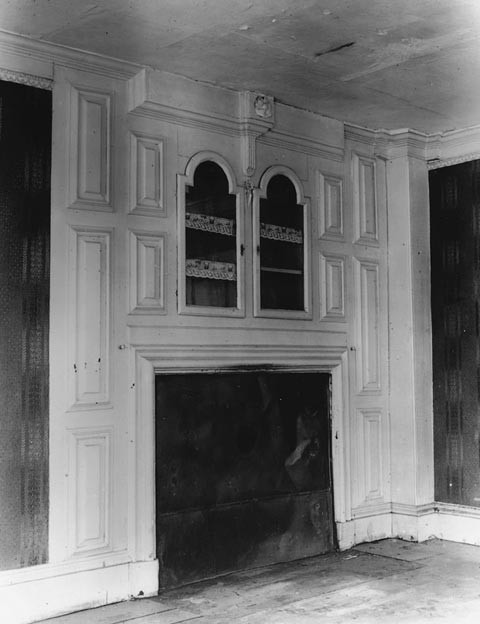
Detail of the interior of Christopher Townsend’s house. (Courtesy, Newport Historical Society.)

Colony House, Newport, Rhode Island, 1739–1749. (Courtesy, State of Rhode Island and Providence Plantations; photo, Gavin Ashworth.)
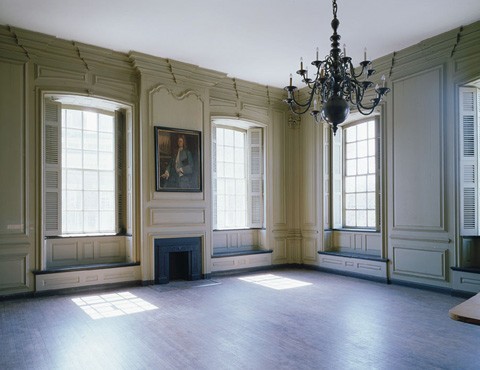
Detail of the senate chamber of the Colony House. (Photo, Gavin Ashworth.)
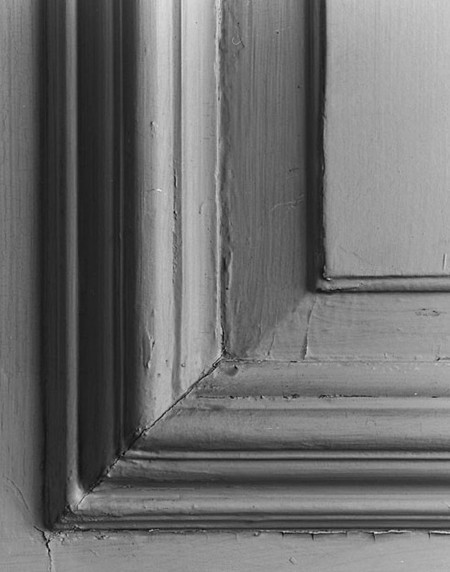
Detail of the paneling in the senate chamber of the Colony House. (Photo, Gavin Ashworth.)

Detail of a newel post in the Colony House. (Photo, Gavin Ashworth.)
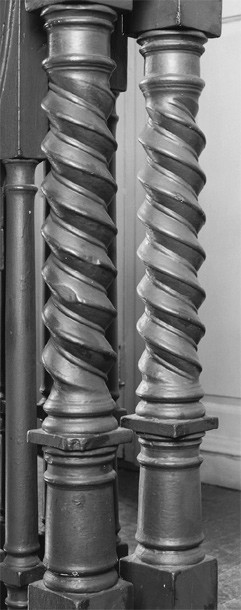
Detail of two newel posts in the Colony House. (Photo, Gavin Ashworth.)
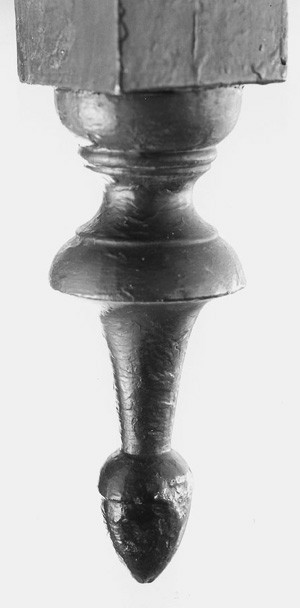
Detail of a turned pendant on a newel post in the Colony House. (Photo, Gavin Ashworth.)
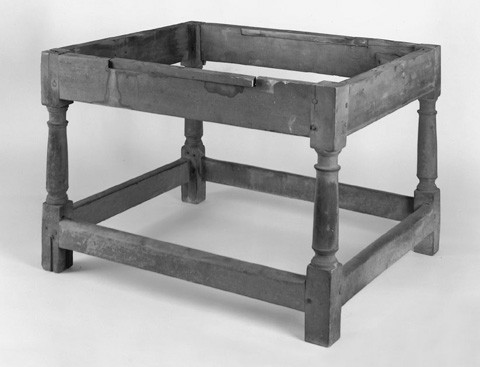
Joined table, Newport, Rhode Island, 1739–1749. Maple and white pine; blue paint.
H. 28 1/2", W. 42", D. 35 3/4". (Courtesy, State of Rhode Island and Providence Plantations; photo, Gavin Ashworth.)

Detail of a leg on the table illustrated in fig. 10. (Photo, Gavin Ashworth.)
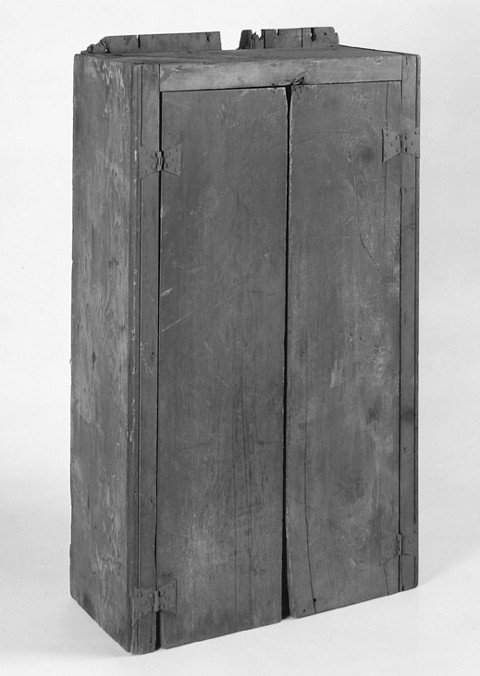
Cupboard, Newport, Rhode Island, 1739-1749. White pine; blue paint. Dimentions not recorded. (Courtesy, State of Rhode Island and Providence Plantations; photo, Gavin Ashworth.)
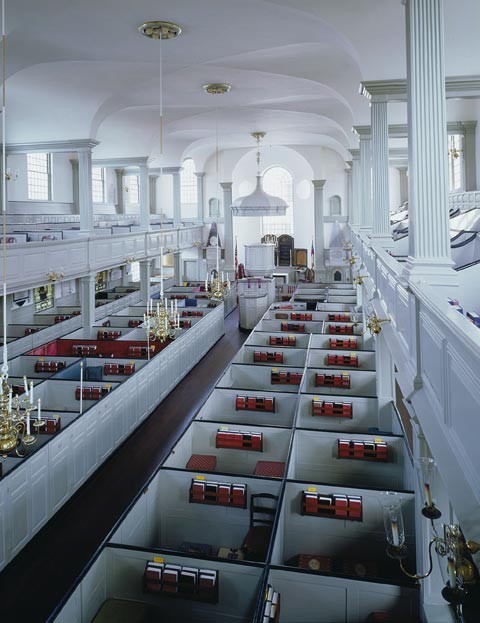
Detail of the interior of Trinity Church, Newport, Rhode Island, 1725–1730. (Photo, Gavin Ashworth.)
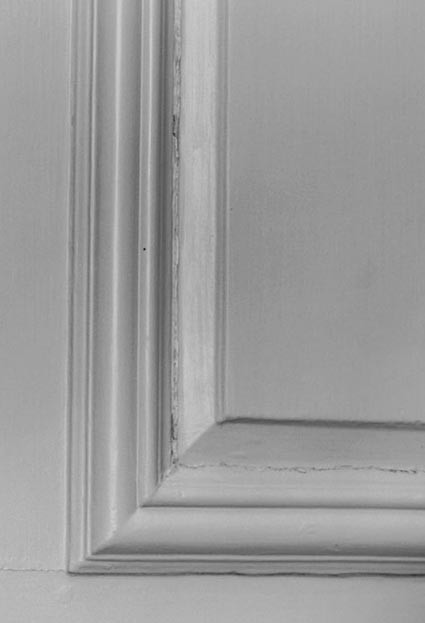
Detail of the paneling in Trinity Church. (Photo, Gavin Ashworth.)
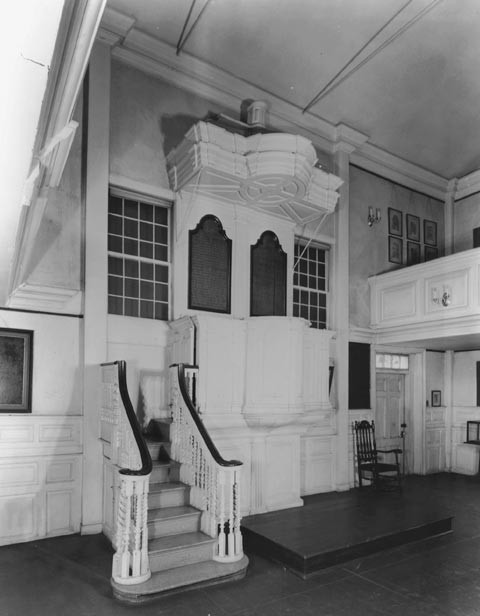
Detail of the interior of the Seventh Day Baptist Meeting House, Newport, Rhode Island, 1725–1730. (Photo, Gavin Ashworth.)
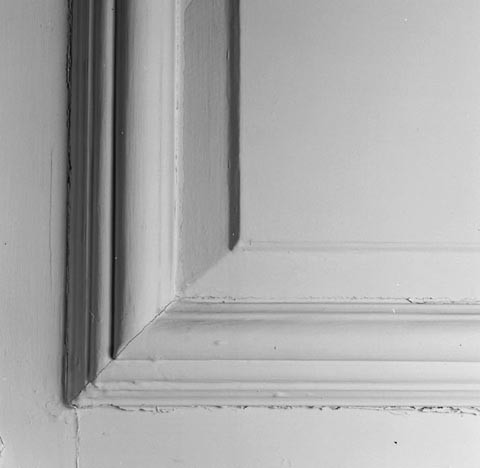
Detail of the paneling in the Seventh Day Baptist Meeting House. (Photo, Gavin Ashworth.)
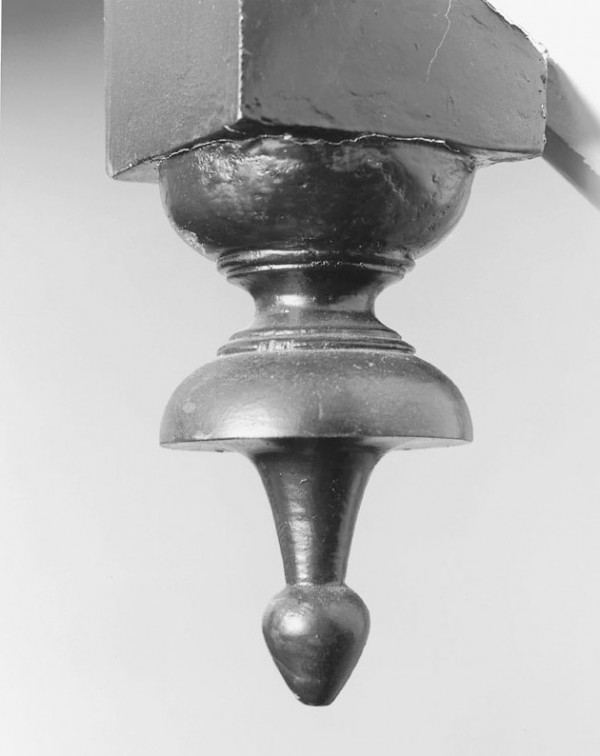
Detail of a turned pendant on a newel post in Trinity Church. (Photo, Gavin Ashworth.)
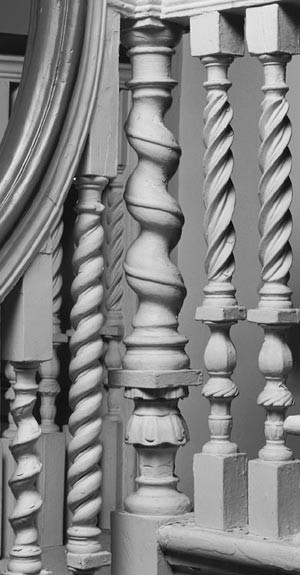
Detail of a newel post and balusters on the stair leading to the pulpit in the Seventh Day Baptist Meeting House. (Photo, Gavin Ashworth.)
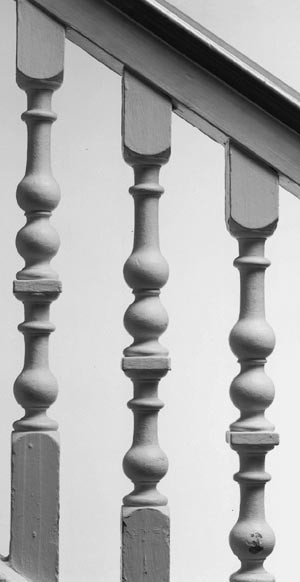
Detail of balusters on the stair leading to the gallery in the Seventh Day Baptist Meeting House. (Photo, Gavin Ashworth.)

High chest attributed to Christopher Townsend, Newport, Rhode Island, 1740–1750. Mahogany with tulip poplar. H. 83 5/8", W. 40 1/2", D. 22 1/4". (Chipstone Foundation; photo, Gavin Ashworth.) The chest retains its original china shelves, brass hardware, and finish.
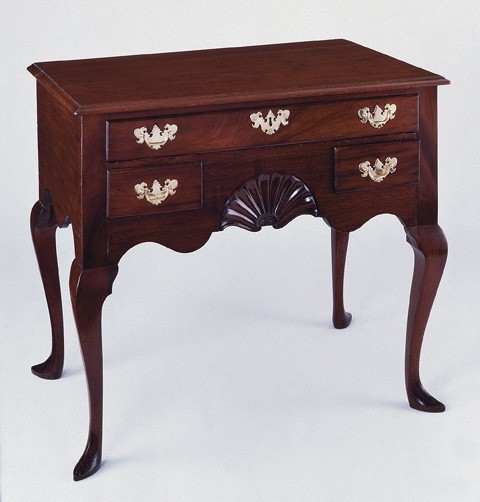
Dressing table attributed to Job Townsend, Newport, Rhode Island, 1746. Mahogany with white pine. H. 30 1/2", W. 34 1/2", D. 22 1/2". (Chipstone Foundation; photo, Gavin Ashworth.)
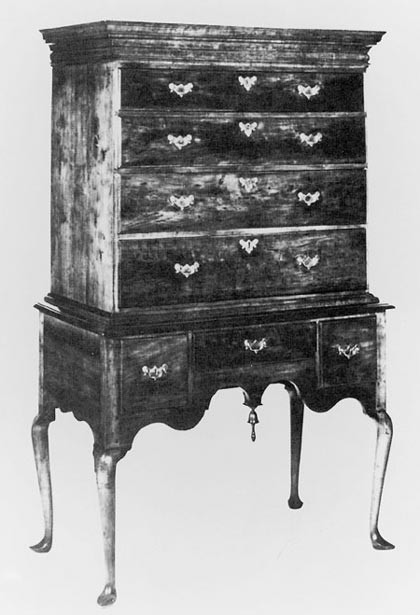
High chest, probably Long Island, New York, 1730–1740. Apple with tulip poplar. H. 70", W. 40", depth not recorded. (Courtesy, Florene Maine and Society for the Preservation of Long Island Antiquities.)
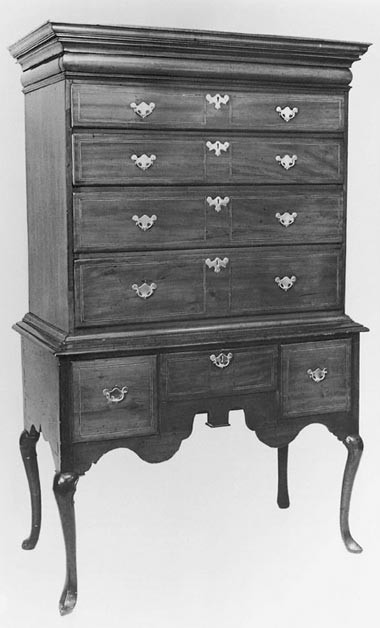
High chest, probably Long Island, New York, 1730–1740. Red gum with pine.
H. 70", W. 43", D. 22". (Private collection; photo, Society for the Preservation of Long Island Antiquities.)
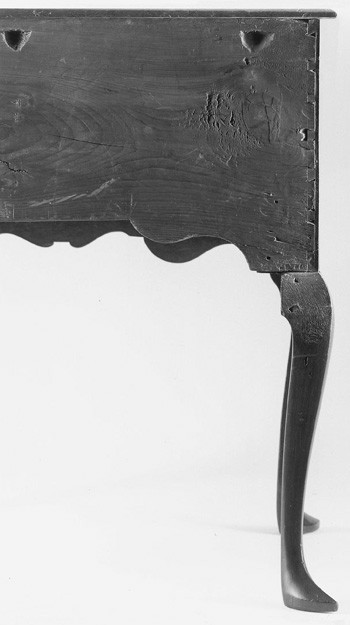
Detail of the dovetailed case construction of the dressing table illustrated in fig. 21. (Photo, Gavin Ashworth.)
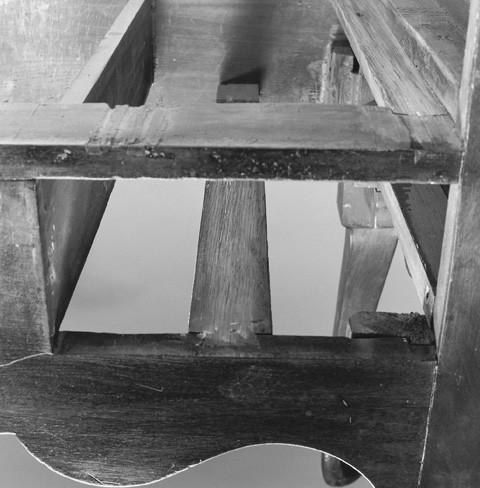
Detail of the case and leg construction of the dressing table illustrated in fig. 21.
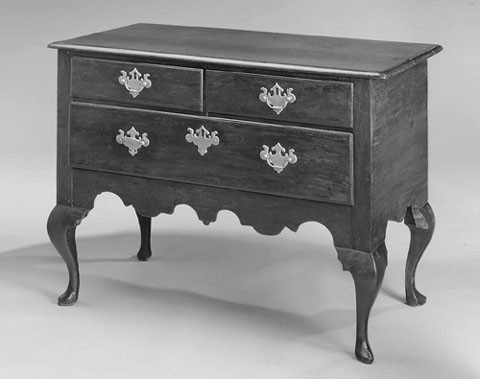
Dressing table, Rappahannock River Basin of eastern Virginia, 1755–1770. Walnut with yellow pine. H. 28 1/2", W. 38", D. 20 1/4". (Courtesy, Sumpter Priddy, Inc.)

Detail of the case and leg construction of the dressing table illustrated in fig. 26.
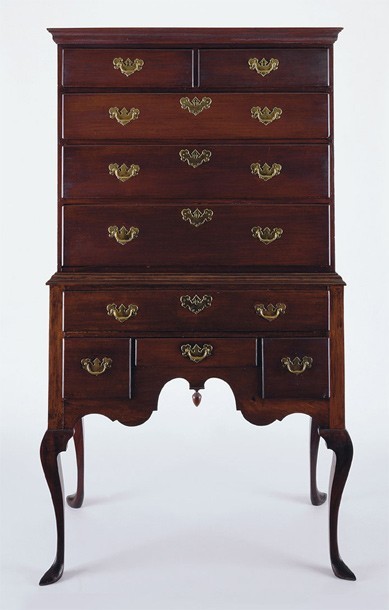
High chest signed by Christopher Townsend, Newport, Rhode Island, 1748. Walnut with pine. H. 70", W. 38 1/2", D. 20 1/2". (Private collection; photo, Gavin Ashworth.)
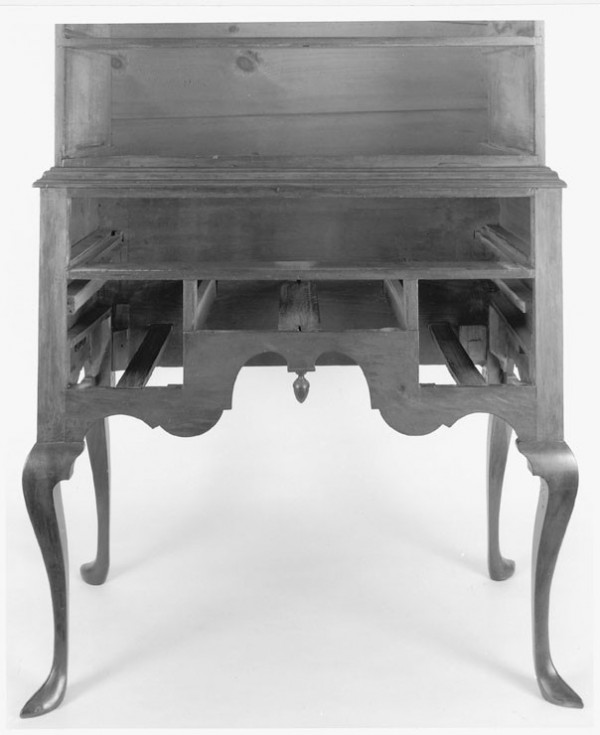
Detail of the case construction of the high chest illustrated in fig. 28. (Photo, Gavin Ashworth.)
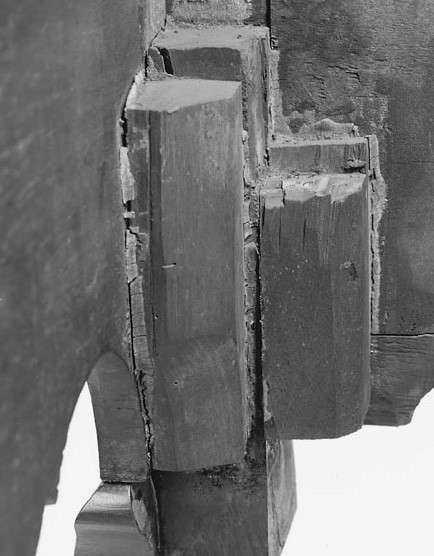
Detail of a rabbeted rear leg on the high chest illustrated in fig. 20. (Photo, Gavin Ashworth.)
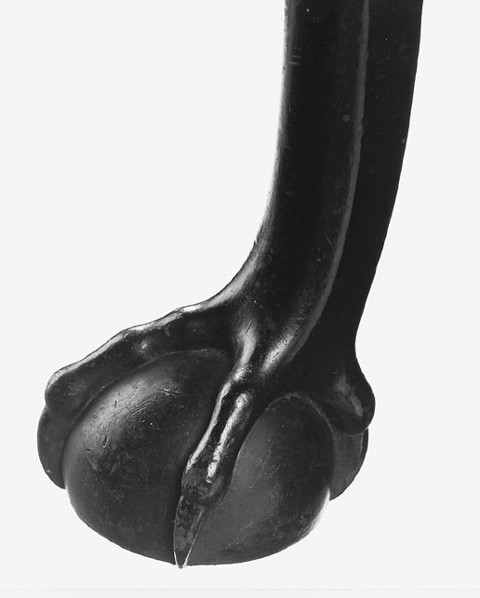
Detail of a foot on the high chest illustrated in fig. 20. (Photo, Gavin Ashworth.)
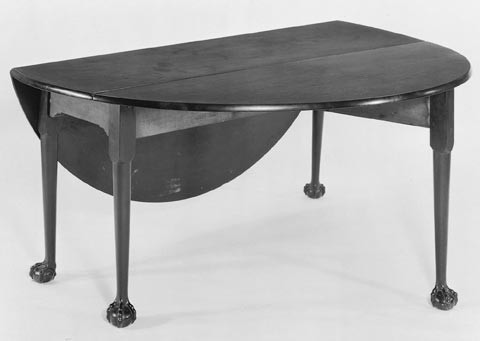
Dining table probably by Christopher or John Townsend, Newport, Rhode Island, 1745–1755. Mahogany with maple and pine. H. 30 5/8", W. 68 1/2", D. 68 3/4" (open). (Courtesy, Colonial Williamsburg Foundation.)
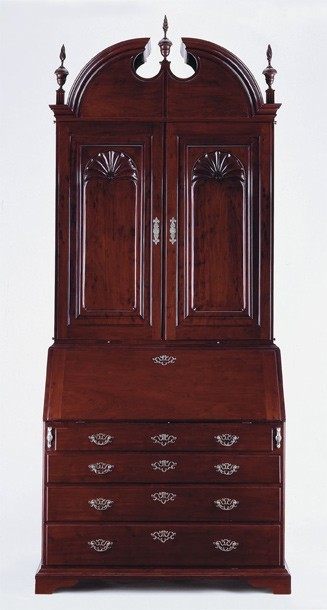
Desk-and-bookcase by Christopher Townsend, Newport, Rhode Island, 1745–1755. Mahogany throughout. Dimensions not recorded. (Private collection; photo, Gavin Ashworth.)
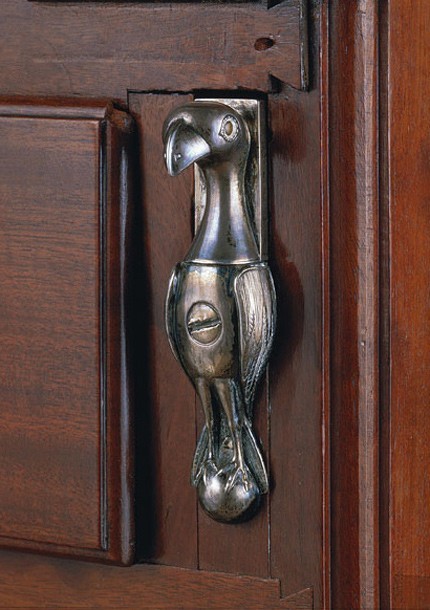
Detail of the silver mount on the right fallboard support of the desk-and-bookcase illustrated in fig. 33. (Courtesy, Sotheby’s.)
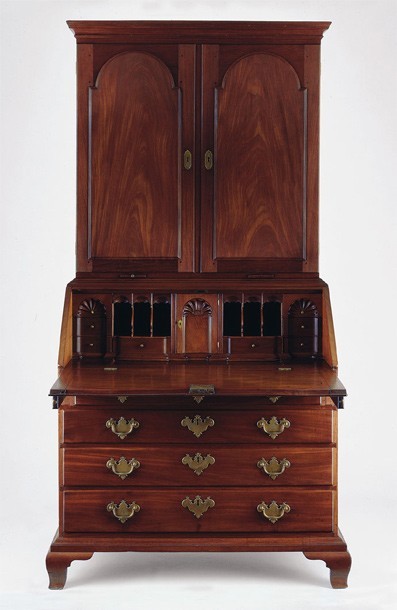
Desk-and-bookcase bearing the label of Job Townsend, Newport, Rhode Island, 1750–1765. Mahogany with chestnut and tulip poplar. H. 82 1/2", W. 40", D. 24 1/2". (Courtesy, Rhode Island School of Design; gift of Mrs. Murray S. Danforth; photo, Gavin Ashworth.) The pediment is missing. www.risd.edu

Desk-and-bookcase attributed to Christopher Townsend, Newport, Rhode Island, 1735–1755. Mahogany with unrecorded secondary woods. H. 108", W. 36", depth not recorded. (Parke-Bernet Galleries, Inc., Important American Furniture from the Estate of the late Cornelius C. Moore, Newport, Rhode Island, New York, October 30, 1971, lot 154.) The door panels are missing, and the feet are incorrect replacements.
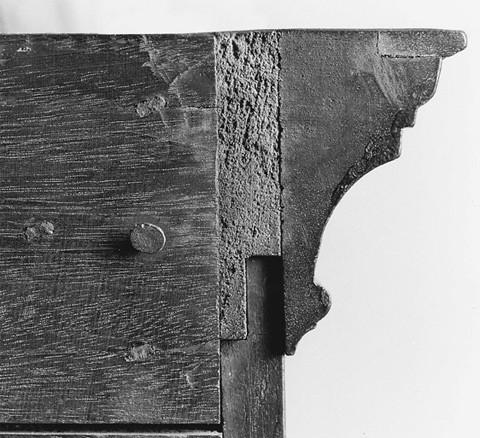
Detail showing the attachment of the cornice molding on the desk-and-bookcase illustrated in fig. 33. (Photo, Gavin Ashworth.)
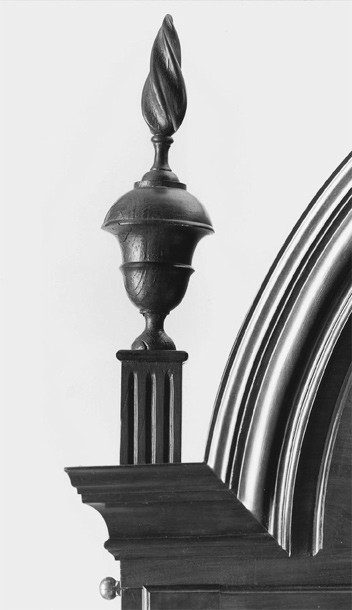
Detail of a finial and section of cornice molding on the desk-and-bookcase illustrated in fig. 33. (Photo, Gavin Ashworth.)
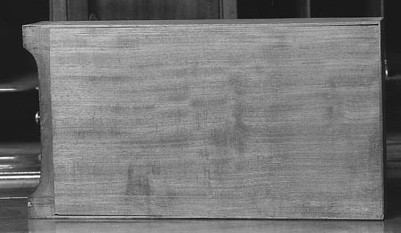
Detail of a glued-in drawer bottom on the desk-and-bookcase illustrated in fig. 33. (Photo, Gavin Ashworth.)
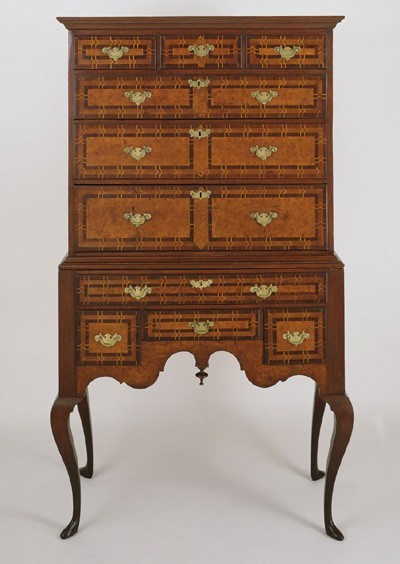
High chest, probably Job or Christopher Townsend, Newport, Rhode Island, 1730–1750. Walnut, maple and walnut veneer, and lightwood inlay with white pine and maple. H. 70 3/8", W. 38", D. 20 1/4". (Chipstone Foundation; photo, Gavin Ashworth.) The mid-molding is replaced.
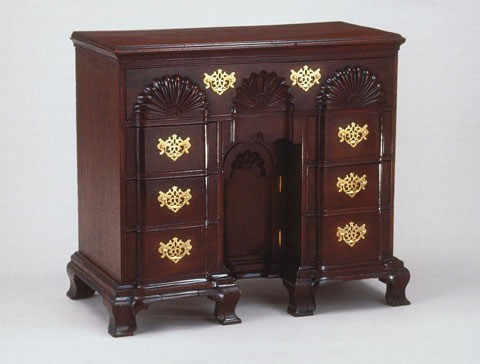
Bureau table, probably Job or Christopher Townsend, Newport, Rhode Island, 1740–1750. Mahogany with white pine. H. 34 1/4", W. 37 1/2", D. 21". (Joseph and June Hennage collection; photo, Hans Lorenz.)
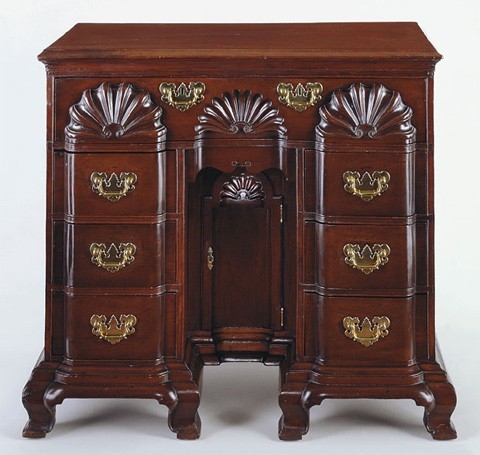
Bureau table, probably Job or Christopher Townsend, Newport, Rhode Island, 1740–1750. Mahogany with white pine. H. 34 1/2", W. 39 1/4", D. 21". (Private collection; photo, Gavin Ashworth.)
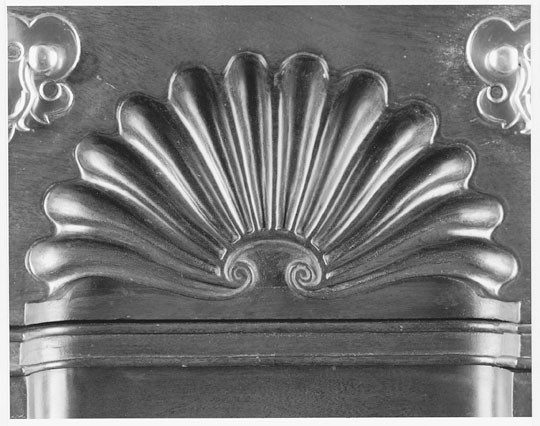
Detail of the concave shell on the upper drawer of the bureau table illustrated in fig. 42. (Photo, Gavin Ashworth.)
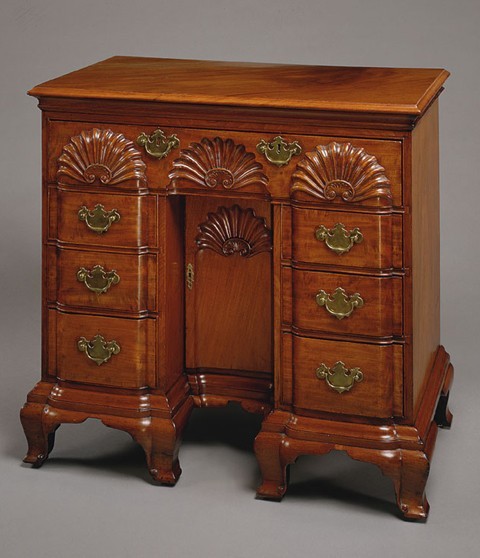
Bureau table attributed to John Townsend, Newport, Rhode Island, 1765–1770. Mahogany with white pine, chestnut, and tulip poplar. H. 34 3/8", W. 36 1/2.", D. 20 1/2.". (Courtesy, The Metropolitan Museum of Art, Gift of Mrs. Russell Sage, 1909 (10.125.83) Photograph © The Metropolitan Museum of Art.)
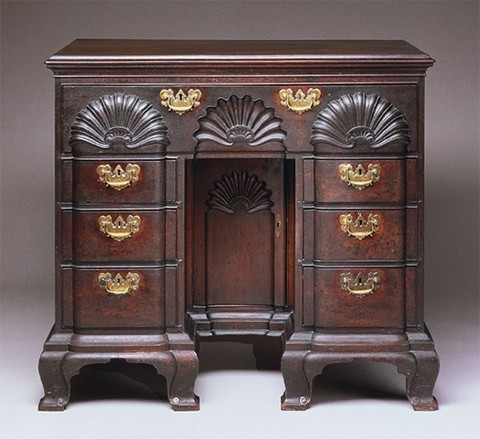
Bureau table attributed to Edmund Townsend, Newport, Rhode Island, 1760–1780. Mahogany with chestnut and white pine. H. 33", W. 36 1/4", D. 20 1/2". (Private collection; photo, Sotheby’s.)
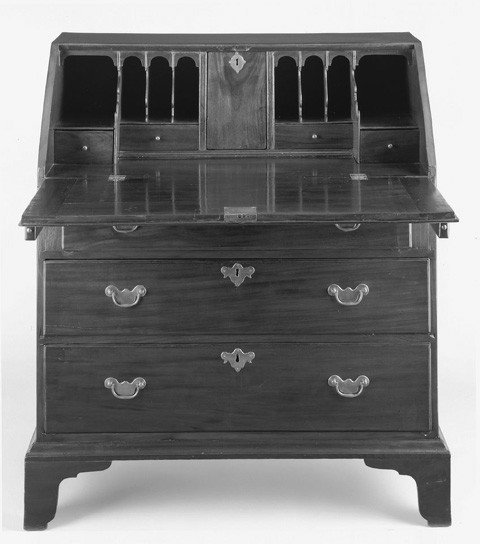
Desk by John Goddard, Newport, Rhode Island, 1745. Mahogany with white pine. H. 42", W. 35 1/2", D. 19". (Chipstone Foundation; photo, Gavin Ashworth.)
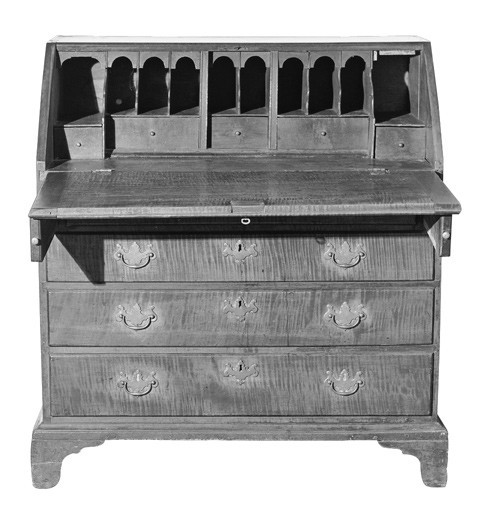
Desk, Newport, Rhode Island, 1760–1770. Maple with chestnut and tulip poplar. H. 40 7/8", W. 38 3/8", D. 20 7/16". (Private collection; photo, Museum of Early Southern Decorative Arts.)
The distinctive and cohesive style of colonial Newport furniture had much more to do with mass-producing a marketable commodity than with the refinement and perfection of furniture forms. From the outset, Rhode Island differed from the other New England colonies. During the 1650s and 1660s, it became a center for Quakerism as members of the Society of Friends sought to escape religious persecution in England and in Massachusetts. This attitude of religious tolerance subsequently extended to other sects. In 1729, Anglican minister George Berkely wrote:
The inhabitants [of Newport] are of a mixed kind. . . . Here are four sorts of Anabaptists, besides Presbyterians, Quakers, Independents, and many of no profession at all. Notwithstanding so many differences, here are fewer quarrels about religion than elsewhere. The people living peaceably with their neighbors of whatever persuasions. They all agree on one point, that the Church of England is second best.
Historian William G. McLoughlin has asserted that “the privatization of religion led to a new emphasis on economic self-interest as a motivating force in the colony.”[1]
Like most other New England cities, Newport had an economy based on processing, manufacturing, and shipping rather than the production of staples such as tobacco, rice, or indigo. The three principal sources of Rhode Island’s wealth were the sugar trade, the slave trade, and fisheries. Ships left the colony with livestock, cheese, barrel staves, lumber, fish, and manufactured goods that could be bartered for tobacco, sugar, or bills of exchange in southern ports and the West Indies. Many of these vessels continued on to Africa, where part of their cargo was exchanged for slaves. Most of the slaves were bartered or sold in the West Indies and southern colonies on the return voyage.[2]
Several subsidiary industries developed as a result of the triangular trade. Rum, which was distilled from West Indian molasses, became Rhode Island’s most important export commodity. In 1741, Governor Richard Ward noted that “the neighboring governments have been in great measure supplied with rum, sugar, molasses, and other West Indian goods by us. . . . Nay, Boston, itself, the metropolis of Massachusetts, is not a little obliged to us.” By 1750, the colony had thirty-three distilleries, twenty-two of which were i Newport. Rhode Island’s shipping industry also grew to meet the demands of increased trade. In 1708, the colony had only 30 ships, which were primarily sloops engaged in the North American coastal trade. The fleet grew to 80 vessels in 1731, to 120 in 1740, to more than 500 in 1763. Artisans, merchants, and entrepreneurs were quick to capitalize on the expansion of the carrying trade. Cabinetmakers, for example, began producing furniture for export as well as for local consumption. At least fifty-six cabinetmakers were active in Rhode Island between 1745 and 1774. By comparison, Boston had approximately sixty-four, although its population, fleet, and manufacturing base were much larger.[3]
As Rhode Island’s economy developed, its dependence on Boston as a source for British manufactured goods decreased. Newport merchant John Banister was among the first to establish direct trade with London. In a 1739 letter to John Thomlinson of London, Banister wrote that the residents of Newport desired “to make themselves independent of the Bay Government to whom they have a mortal aversion.” Like Banister, many Rhode Island merchants and tradesmen resented Boston’s dominance of the coastal trade in manufactured goods. Since the late seventeenth century, the “metropolis of Massachusetts” had led all New England ports in the export of such items as British textiles and locally made furniture, particularly chairs. Although Newport merchants and tradesmen did not ship significant quantities of furniture before mid-century, the social, economic, and cultural forces that allowed them to compete with Boston emerged decades earlier. During the 1720s, artisans such as Job and Christopher Townsend began developing efficient methods of production and securing the patronage of local merchants and ship captains who would become allies in the furniture export trade.[4]
Members of the Townsend family of Oyster Bay began immigrating to Newport during the seventeenth century. Widower Thomas Townsend, whose mother and aunts had grown up in Newport, arrived about 1686 and married Mary Almy. His son John and nephew Solomon married into the same family, consolidating their positions among the Quaker communities in Newport and Oyster Bay. John and his wife Rebecca moved from Newport to Long Island about 1694, and Solomon, his wife Catherine, and children Job (1699–1765), Christopher (1701–1787), Solomon, and Hannah moved from Long Island to Newport in 1707.[5]
The earliest documented Newport furniture is associated with Job and Christopher Townsend. Although their training remains a mystery, they probably served their apprenticeships between 1713 and 1721. Similarities in the construction of their furniture suggest that both brothers had the same master. Job married Rebecca Casey in 1722, and referred to himself as a carpenter the following year. The earliest reference to him making furniture, however, is a 1733 letter in which Christopher describes a desk-and-bookcase that Job sold for £59.[6]
Christopher married Patience Easton (1703–1789) in 1723. Her grandfather, Nicholas, was an English-born tanner who arrived with the first Quaker settlers in the region. Her step-grandmother, Ann Bull Easton, left the Quakers a tract of land called Easton’s Point, which became one of the town’s leading residential and manufacturing centers (fig. 1). Christopher undoubtedly profited from his association with the Eastons. Patience’s brothers were in the house-joinery, shipbuilding, and furniture-making trades, and several other members of her family were ship captains.[7]
Christopher and Job both settled at Easton’s Point. Job purchased lot 86 and Christopher purchased lots 49 and 51. Job’s house was demolished during the mid–twentieth century, but Christopher’s still stands with his shop attached to one side (fig. 2). The shop, which measures 12' x 24', is comparable in size to those managed by contemporaries such as Constant Bailey. As historian Margaretta Lovell has noted, the small size of these shops suggests that they were not the sole place of production. Like other urban artisans, Newport cabinetmakers undoubtedly purchased components and commissioned services such as carving and gilding from other tradesmen.[8]
During the 1720s and 1730s, Job and Christopher may have spent much of their time working as house joiners. Evidence suggests that each built his own house (see figs. 2, 3) and received commissions for public and private buildings. Accounts pertaining to the construction of the Colony House (fig. 4) reveal that Christopher Townsend was the principal joiner and that Thomas Melvil and Israel Champan were hired as carpenters. Townsend probably furnished many of the interior components including the paneling in the senate chamber (figs. 5, 6 ) and the stair balusters and newel posts (figs. 7-9). He may also have constructed two turned and joined tables (figs. 10, 11) that were among the original furnishings. These tables, which have turning sequences identical to those on the stair, probably stood in either the senate chamber or courtroom below.[9]
Many eighteenth-century cabinetmakers supplemented their income by doing house joinery. Their work often entailed fabricating architectural components such as chimneypieces, paneling, and “bowfats” as well as more mundane fixtures like the cupboard illustrated in fig. 12. The cupboard probably dates from the mid-1740s, when Christopher Townsend and the carpenters working on the Colony House were completing their work. It has finely wrought dovetail hinges and remnants of dry pigment that appear to match the blue paint on the joined tables.
Architectural historians Antoinette F. Downing and Vincent J. Sculley, Jr., were the first to note that elements of the frame and panel moldings in the senate chamber of the Colony House (fig. 6) match those in Trinity Church (figs. 13, 14) and the Seventh Day Baptist Meeting House (figs. 15, 16). Although it is possible that other Newport joiners owned sets of planes similar to those of Christopher Townsend, his involvement with these buildings and several contemporary houses is quite plausible. The newel posts on the gallery stair in Trinity Church have distinctive, acorn-shaped pendants or “drops” (fig. 17) that appear to be precursors to those in the Colony House (fig. 9), and the “barley-twist” balusters in the Seventh Day Baptist Meeting House (fig. 18) are similar to those shown in figure 8. A furniture joiner like Christopher Townsend undoubtedly worked on the interior of the meeting house. The balusters on the gallery stair (fig. 19) have turnings that match those on a group of Newport gateleg tables from the 1720s and 1730. Oral tradition credits Newport master builder Richard Mundy, the “architect” of the Colony House with the design of the Seventh Day Baptist Meeting House and Trinity Church.[10]
The earliest reference to Christopher’s working in the furniture-making trades is his purchase of hardware, nails, and other materials in 1732. On February 4, 1738, Christopher wrote Newport merchant Abraham Redwood:
According to thy Request . . . I indevoured to finish a Desk and Book Case Agreeable to thy directions to send thee by Brother Pope but could not quite finish . . . and understanding it was not for thee but a friend of thine, I concluded it would be Equal to thee, If I send it by another opertunity. And having an opertunity to send it by Brother Solomon, I . . . ordered him to Deliver it to thee or thy order, thou paying him one Moyodore freight, the Desk and Bookcase amounts to Sixty Pounds this currency; includeing the two Ruf cases which is equal to fourteen heavy Pistole at £4.5.8 or fourty-four ounces and a half of Silver. . . . I may let thee know that I sold such a Desk and Book Case without any Ruf cases, for £58 in hand this winter. Brother Job, also sold one to our Collector for £59. I mention this, that thou may know that I have not imposed on thee.
Christopher had several important patrons in addition to Redwood. In 1742, he sold Newport merchant Isaac Stelle a desk-and-bookcase for £65. Christopher may also have worked for Samuel Ward, who served as Governor of Rhode Island twice during the 1760s. The high chest illustrated in figure 20 descended in his family, and Ward is known to have purchased at least eight pieces of furniture from Job Townsend.[11]
The dressing table illustrated in figure 21 is the earliest piece of furniture that can be associated with Job. It is thought to be the one valued at £13.10 in his 1746 bill to Quaker merchant Samuel Ward:
| Bot of Job Townsend |
| a mahogany High Chest of Drawers | £30.0.0 |
| a mahogany Dressing Table | 13.10.0 |
| a mahogany Dining Table 5 foot 6 in at 65/ | 17.7.6 |
| 1 ditto 4 foot 8 in at 65/ | 15.3.4 |
| a mahogany tea table | 8.10.0 |
| 1 Square Kitchen table | 5.0.0 |
| a maple tea table | 2.10.0 |
| a maple stool | 2.0.0 |
| £94.10.10 |
The slipper feet and cyma reversa curves of the front rail are repeated, with minor variation, on Long Island high chests and dressing tables made during the late 1720s and 1730s. With a history of descent in the Cox family of Oyster Bay, the high chest shown in figure 22 is one of the earliest New York examples. Its bold ogee cornice, pulvinated frieze, and broad waist molding have parallels in baroque case furniture made in New York City, Flushing, and Oyster Bay. At least five high chests and two dressing tables appear to be from the same shop as the Cox example, the most elaborate of which have knees with carved strapwork and thick line inlay on the drawer fronts (fig. 23). One high chest reputedly belonged to Oyster Bay merchant Samuel Townsend, who was a relative of Job and Christopher. Samuel married Sarah Stoddard, whose father William was a cabinetmaker. William probably moved from Rhode Island to Oyster Bay during the mid-1720s.[12]
Like many Rhode Island Quakers, Job and Christopher Townsend maintained ties with family members and business associates in New York City and Long Island. Christopher attended the New York Men’s Monthly Meeting at least twice during the early 1740s and consigned furniture to Quaker cabinetmaker Joshua Delaplaine in 1744. In exchange, Delaplaine shipped Townsend flour, bread, butter, and milk. Delaplaine had been selling foodstuffs to Quaker merchants in Newport since the early 1730s. One of his patrons, Samuel Holmes, was an acquaintance of Christopher Townsend. Like the case pieces mentioned above, these commercial and familial connections strongly suggest that Quaker communities functioned as conduits for the movement of people, ideas, and styles during the seventeenth and eighteenth centuries.[13]
Although the high chests and dressing tables attributed to Christopher and Job Townsend share details with early New York examples, their construction is entirely different. The New York pieces have cabriole legs that are joined to the back, sides, and front rails with mortise-and-tenon joints (figs. 22, 23), whereas the Newport ones have dovetailed cases and legs that are attached to the inside corners with glue and glue blocks (see figs. 24, 25, 30). The dovetails on the front corners of Newport high chests and dressing tables are typically concealed by thick, vertical strips of veneer. Considering the fact that Christopher and Job apprenticed during the 1710s and early 1720s, it is logical to assume that some of their construction techniques developed from earlier practices. Baroque high chests and dressing tables almost invariably have dovetailed cases and turned legs that are tenoned into blocks glued (or glued and nailed) to the inside corners. Further research may reveal Irish antecedents for these distinctive Newport construction features. An unusual dressing table from the Rappahannock River Basin of eastern Virginia has a dovetailed case and angular cabriole legs that are attached with glue and glue blocks like those on most Newport high chests and dressing tables (figs. 26, 27). As furniture historian Ronald L. Hurst has observed, Irish influences account for many of the stylistic and structural features found on mid–eighteenth-century tables and chairs from Virginia’s Northern Neck.[14]
Scholars have long contended that Newport cabinetmakers used glued-on legs to facilitate transport, but evidence suggests otherwise. If cases and legs were shipped disassembled, why do none of the examples with southern histories have glue blocks made of indigenous woods such as yellow pine or cypress? A more logical explanation for the persistence of this structure and its use by virtually every cabinetmaker in colonial Newport is that it saved time and materials. A tradesman could cut and fit the dovetails for the lower case of a high chest or the carcass of a dressing table (fig. 24) faster than chopping and fitting the fourteen or more mortise-and-tenon joints required to construct a comparable form. Because the cabriole legs of Newport case pieces have much shorter stiles than those attached with mortise-and-tenon joints, they required less wood. A Newport cabinetmaker could conceivably produce five legs with the same amount of stock required to make four legs using mortise-and-tenon joinery. Evidence also indicates that Newport cabinetmakers and carvers produced legs as piecework and sold them to other tradesmen in town. In 1759, William Barker charged fellow cabinetmaker Benjamin Hunt £1.5 for “1 set legs” and on numerous occasions in 1774 Joseph Martin paid £1.2 for sets of legs. With four saw cuts, virtually any Newport leg could be adapted to fit a given case.[15]
The patterns and construction techniques used by Christopher Townsend differed slightly from those of his brother. The high chest illustrated in figure 28 is the earliest documented example of his work. Its delicate slipper feet, angular cabriole legs, and lower case construction (fig. 29) are similar to those of the Ward family dressing table, but the skirt has cyma curves interrupted with fillets and arches rather than a carved shell.
Judging from the Ward dressing table and the high chests illustrated in figures 20 and 28, Christopher Townsend’s construction was superior to that of his brother. His dovetailing tends to be more precise, and the interior surfaces of his stock are better finished. The high chest shown in figure 20 and a slipper-foot dressing table (in the Metropolitan Museum of Art) display additional features that occasionally occur on work attributed to Christopher’s shop. On both examples, the rear legs are glued into shallow rabbets planed in the backboard (fig. 30). These rabbets increased the glue surface and made the joints stronger.
From the standpoint of form, the high chest illustrated in figure 20 is the most elaborate example attributed to Christopher Townsend and the only Newport piece with stepped shelves for displaying valuables. The shelves are made in three sections and attached to the upper case with glue blocks and nails driven through the scalloped backboard into the upper edge of the top. Typical of Christopher Townsend’s work, the front corners of the shelves have finely cut dovetails that are smaller versions of those on the case drawers. Although “china shelves” are rare in New England furniture, the feet of the high chest (fig. 31) are equally noteworthy features. With their ovoid balls and competently carved toes, these feet are much less mannered than those of other Newport tradesmen. The toes are also more “professional” in being finished with gouges and chisels rather than with abrasives as was most Newport carving.
The dining table illustrated in figure 32 and a high chest discussed in Michael Moses’ Master Craftsmen of Newport are the only other Rhode Island objects with related feet. All of these feet have flattened ovoid balls and no webbing between the toes (see fig. 31). The toes of the dining table have larger knuckles and shorter claws than those on the high chest; however, the feet on these pieces have more in common with each other than with other Newport work. Other features of the dining table have parallels in furniture documented and attributed to Christopher Townsend and his son John (1732/33–1809). The frame has tightly interlocking dovetails cut at approximately the same angle as those on the high chest, three cross-braces dovetailed to the upper edge, and two cross-braces dovetailed and nailed to the bottom edge. Separating the work of these two tradesmen is extremely difficult because John Townsend trained with his father. Many pieces attributed to him may be by Christopher, who worked for nearly sixty years and amassed an estate greater than any other cabinetmaker in his extended family.[16]
The pinnacle of Christopher Townsend’s known work is a desk-and-bookcase (fig. 33) that reputedly belonged to Reverend Nathaniel Appleton (1693–1784) and his wife Margaret (Gibbs) (1699–1771). Appleton graduated from Harvard College and served as minister of the First Church in Cambridge, Massachusetts, from 1717 until his death in 1784. Three of his children also attended Harvard, including his son Nathaniel (junior) (1731–1798) who reputedly inherited the desk-and-bookcase. The piece subsequently passed to the younger Nathaniel’s son John (1758–1829), to his son John-James (1792–1864), to his son Charles-Louis (1846–1935), to his son Henri.[17]
Although the façade of the desk section is relatively plain, it is fitted with ornate silver pulls, escutcheon plates, and bird-shaped mounts (fig. 34) by Samuel Casey (ca. 1724–1779). Casey apprenticed with Boston silversmith Jacob Hurd and established his own shop in Exeter, Rhode Island, by 1745. Five years later he moved to Kingston, about seventeen miles west of Newport across the Naragansett Bay. Casey evidently cast the bird-shaped mounts from patterns carved by Christopher Townsend or one of his associates. Two Newport desks have fallboard supports with similarly carved wooden birds, and another has cast brass mounts of the same basic pattern. The silver mounts on the desk-and-bookcase differ from the brass ones primarily in having inlaid agate eyes.[18]
The interior of the desk section features a central prospect compartment with a shell-carved door flanked by blocked drawers surmounted by pigeonholes with turned and carved valances and tiers of three drawers. The two lower drawers in each tier are blocked and the upper ones have carved shells. This interior design is very similar to that of a desk-and-bookcase made by Job Townsend (fig. 35) and another example attributed to Christopher (fig. 36). As Christopher’s letter to Abraham Redwood suggests, he and Job were familiar with each other’s designs, prices, and patrons. They may have collaborated on important projects and farmed out work to each other and to other family members.[19]
The upper section of the desk-and-bookcase has only one parallel in Newport furniture (see fig. 36). It features an enclosed domed pediment, which may have been inspired by imported British examples, and doors with complex panel moldings and shells carved in relief. In typical Newport fashion, the lobes of the shells were originally finished with an abrasive. Although the cornice molding is an enlarged version of that on the high chests documented and attributed to Christopher Townsend, its attachment is different. The pieces on the sides of the bookcase are rabbeted in addition to being glued and nailed (fig. 37). The molded plaques on the tympanum of the desk-and-bookcase are one of the most conventional features. The finials also relate to Newport work, but they are more attenuated than those on other regional case forms (fig. 38).[20]
The interior of the bookcase is fitted with shelves, pigeonholes with elaborately shaped dividers, blocked drawers, and a prospect compartment flanked by document drawers with Doric column appliqués. The document drawers are unusual in having sides that are glued as opposed to being nailed or dovetailed. Like some of his contemporaries, Christopher Townsend often used nothing more than glue to secure drawer components, moldings, and other elements. The small drawers of the desk-and-bookcase, for example, have bottom boards that are glued into rabbets in the front, sides, and back (fig. 39).[21]
The stock preparation, dovetailing, and blocking on the desk-and-bookcase are meticulous, but other aspects of its construction are relatively coarse by contemporary urban standards. Like the upper cases of the high chests illustrated in figures 20 and 28, the desk section has drawer blades with exposed dovetails and drawer supports that are nailed to the sides of the case. Nailed supports prevent the sides from expanding and contracting with seasonal changes in temperature and humidity. As a result, they can force the drawer blades and backboards out of their joints and cause the sides to split. Nailed supports are, however, faster and cheaper to install than dustboards.
As furniture historian Wallace Gusler has noted, styles and construction techniques were profoundly influenced by the “economic and commercial conditions prevailing at the time and place . . . [of manufacture] as well as by the professional and ethnic background of the maker.” From the outset, cabinetmakers like Christopher and Job Townsend understood the potential of the middle-class market in Rhode Island and abroad. They had witnessed the success of Boston artisans, merchants, and entrepreneurs who shipped vast quantities of furniture to nearly every colonial port. To compete for a segment of this market, Newport tradesmen had to develop construction methods that saved time and materials and form partnerships with other tradesmen, ship captains, and merchants.[22]
Collaborative arrangements helped small shops increase production and cut costs. Job and Christopher Townsend’s extended family included at least twelve joiners. Artisans within this circle probably purchased materials together; sold each other lumber, prepared stock and piecework; and formed partnerships to produce and ship venture cargo. Job and Christopher, for example, purchased brasses, locks, screws, and nails from their brother Solomon, who also shipped furniture for them. Their brass purchases suggest that Christopher made at least two major case pieces each month, whereas Job made approximately four. The latter’s son Job Townsend, Jr., purchased mahogany and at least one set of maple legs from his brother-in-law John Goddard and helped his brother Edmund Townsend make a “Large Mahogany Desk” for Nicholas Anderese in 1767.[23]
A desk-and-bookcase formerly in the collection of Cornelius C. Moore (fig. 36) also appears to be from Christopher Townsend’s shop. Like the preceding example (fig. 33), it has a tall bookcase section with an enclosed ogee head and applied panels on the tympanum. The tympanum openings, panel shapes, and cornice moldings differ, however. On the Moore piece, the tympanum and panel arcs are larger and the cornice molding has a bold cyma reversa element rather than a cove. The desk sections differ primarily in the width of the drawers on either side of the prospect door and the number of pigeonhole brackets above them. Not surprisingly, the Moore desk, which has one less pigeonhole, is slightly narrower than Appleton’s.[24]
An imported case piece may have inspired the design of the Moore and Appleton desk-and-bookcases. Domed pediments were popular on British desk-and-bookcases, chest-on-chests, and tall clock cases from the late 1600s to the 1720s. Architectural books represent another possible source for Townsend’s designs. Prototypes for his domed pediments can be found in numerous volumes including William Salmon’s Palladio Londonensis (1734), James Gibb’s Book of Architecture (1728), and Batty Langley’s The City and Country Builder’s and Workman’s Treasury of Designs (1740).
Although external styles clearly influenced Rhode Island furniture, evidence suggests that Newport cabinetmakers intentionally developed forms that were very different from those made in Boston, New York, and Britain. In effect, they created a “brand name,” a style recognizable both to local consumers and those in distant ports. In The London Tradesman (1747), Robert Campbell observed: “He who first hits upon any New Whim is sure to make by the Invention before it becomes common in the Trade; but he that must always wait for a new Fashion till it comes from Paris, or is hit upon by his neighbor, is never likely to grow rich or eminent in his Way.” The “new whim” that contributed to the success of Newport artisans was not really new at all. Instead, it involved the distillation, modification, and, often, exaggeration of stylistic details from Boston, New York, Britain, continental Europe, and the Orient. During the late 1730s, Newport cabinetmakers began codifying these details, and by 1750 they had refined them to the point that stylistic changes from shop to shop remained almost imperceptible for the next half century.[25]
Two factors reinforced this stylistic hegemony. Most Newport shops were connected either through marriage or trade associations. Christopher Townsend, for example, trained his sons Job, Edmund, Thomas, and John Townsend, who in turn passed their knowledge on to the next generation. Similarly, John Goddard apprenticed with Job Townsend, married his daughter Hannah, and trained three of their sons. Because of the importance of the venture cargo trade, artisans within these family networks appear to have focused their efforts on competing with Boston tradesmen and merchants rather than with each other.
Newport’s large Quaker population also had a profound influence on local styles. Like Pennsylvania Quaker William Penn, some members of the sect endeavored to “avoid the vain arts and inventions of a luxurious world.” Newport cabinetmakers and their patrons typically eschewed such superficial forms of decoration as gilding and veneer in favor of solid figured woods and restrained carving. The high chest illustrated in figure 40 is the only veneered case piece attributed to an eighteenth-century Newport shop. Its drawer construction, cornice molding, and skirt shape are consistent with work attributed to Job and Christopher Townsend, but the unusually thick leg stock and composite core of the lower case suggest that the maker was unaccustomed to producing veneered forms. By contrast, the structure of conventional Newport high chests varies little from piece to piece.[26]
The standardization of style and construction clearly occurred at all levels of production. The bureau tables shown in figures 41 and 42 probably date from the late 1740s or early 1750s and are the earliest Newport examples known. Their wood selection, case construction, dovetailing, and shell carving have close parallels in furniture attributed to Job Townsend and John Goddard. The concave shells (fig. 43), for example, are similar to those on the waist doors of a circa 1755 tall clock case that furniture historian Michael Moses associates with Goddard and an earlier example (in the Winterthur Museum) with a movement by James Wady. Unlike most Newport bureau tables from the 1760–1780 period, which vary primarily in the number and detail of their carved shells, these examples have an experimental quality to their construction and design. The cyma-shaped drawers above the recesses on the early examples represent a departure from conventional Newport work. These drawers appear to have been inspired by those on Boston bureau tables, which were undoubtedly imported into Rhode Island during the second quarter of the eighteenth century.[27]
Later bureau tables attributed to John Townsend (fig. 44) and his cousin Edmund (fig. 45) demonstrate how Newport cabinetmakers “perfected a narrow range of designs and motifs” for this form. Both pieces are made of dense figured mahogany, and both have blocked façades, an upper drawer with a concave relief-carved shell flanked by two convex applied shells, a recess with a paneled door and a concave shell, cyma-and-fillet base moldings, and similar ogee feet. Aside from minor differences in construction and carving, these pieces are visually the same even though their makers trained in different shops. The same can be said about other case forms and tables produced by the Townsends and Goddards as well as by their non-Quaker contemporaries.[28]
In the venture cargo arena, Newport cabinetmakers were so successful that they had little need to develop new forms. John Goddard made the desk illustrated in figure 46 in 1745, shortly after he completed his apprenticeship with Job Townsend. Aside from its mahogany primary wood, it differs little from a circa 1765 desk (fig. 47) that descended in a family from Edenton, North Carolina—undoubtedly a relic of the coastal furniture trade. Most Newport cabinetmakers produced desks of this type. Christopher Townsend, the most successful of the town’s cabinetmakers, left his son John a one-third interest in all of the unfinished desks in his shop, except for one large mahogany example made by his son Jonathan. Maple desks like the one shown in figure 47 probably accounted for a much higher percentage of Christopher’s income than elaborate table and case forms.[29]
Although plain maple desks and simple pad-foot tables may be visually less appealing than the great shell-carved, blockfront case pieces and serpentine tables attributed to the Townsends and Goddards, they are, nevertheless, critical to understanding the origin and development of Newport furniture styles. Early cabinetmakers like Job and Christopher Townsend understood that mass-producing furniture for the middle-class market and export trade could be more profitable than commissioned work. Judging from the small body of furniture that can be documented and attributed to their shops, they developed many of the procedures for quickly and efficiently manufacturing furniture that are manifest in even the most costly Newport pieces. They also established much of the stylistic vocabulary that gave and continues to give the town’s furniture its “brand appeal.”
ACKNOWEDGMENTS
For assistance with this article, the author thanks Gavin Ashworth, Ralph Carpenter, Dean Failey, John Hays, Leigh Keno, Leslie Keno, Deanne Levison, Jack Lindsey, John Nye, Nancy Sazama, Robert Trent, Joan Youngkin, and the museums and collectors who shared their knowledge and objects. I am especially grateful to Joan Barzilay Freund for her research on Newport Quakers and to Jeanne Vibert Sloane and Margaretta M. Lovell for their insightful publications on the cabinetmaking business there.
William G. McLoughlin, Rhode Island (New York: W. W. Norton, 1978), pp. 46, 71 (for the Berkely quote), and passim.
Ibid, pp. 63–65.
Ibid., p. 64. As quoted in Elaine Forman Crane, A Dependent People: Newport, Rhode Island in the Revolutionary Era (New York: Fordham University Press, 1985), p. 11. McLoughlin, Rhode Island, p. 58. Jeanne Vibert Sloane, “John Cahoone and the Newport Furniture Industry,” in New England Furniture: Essays in Memory of Benno Forman, edited by Brock Jobe (Boston: Society for the Preservation of New England Antiquities, 1987), p. 91.
As quoted in Leigh Keno, Joan Barzilay Freund, and Alan Miller, “The Very Pink of the Mode: Boston Georgian Chairs, Their Export and Their Influence,” in American Furniture, edited by Luke Beckerdite (Hanover, N.H.: University Press of New England, 1996), p. 298. For more on the export of Rhode Island furniture, see Sloane, “John Cahoone.” Margaretta M. Lovell, “‘Such Furniture as Will Be Most Profitable’: The Business of Cabinetmaking in Eighteenth-Century Newport,” Winterthur Portfolio 26, no. 1 (Spring 1991): 52–56.
Ralph E. Carpenter, Jr., The Arts and Crafts of Newport, Rhode Island, 1640–1820 (Newport, R.I.: Preservation Society of Newport County, 1954), pp. 10–13. Lovell, “‘Such Furniture as Will Be Most Profitable,’” p. 53.
Mabel M. Swan, “The Goddard and Townsend Joiners, Part I,” Antiques 49, no. 4 (April 1946): 228–31. In 1718, Christopher was serving on the Elizabeth when a pirate sloop robbed the ship and took two sailors. Carpenter, The Arts and Crafts of Newport, pp. 10–13.
Lovell, “‘Such Furniture as Will Be Most Profitable,’” pp. 53, 56.
Carpenter, The Arts and Crafts of Newport, pp. 11, 12. Antoinette F. Downing and Vincent J. Scully, Jr., The Architectural Heritage of Newport, Rhode Island, 1640–1915 (1952; 2d rev. ed., New York: American Legacy Press, 1967), pp. 75–76. Lovell, “‘Such Furniture as Will Be Most Profitable,’” pp. 50–52.
Downing and Scully, The Architectural Heritage of Newport, p. 63.
Ibid.
Abraham Redwood Letterbook, 1723–1740, as quoted in Ethel Hall Bjerkoe, The Cabinet-makers of America (New York: Doubleday, 1957), pp. 213-14. Carpenter, The Arts and Crafts of Newport, pp. 11–12. Public commissions, which required the support and involvement of prominent individuals, were important avenues of patronage for colonial tradesmen. Christopher Townsend worked as a house joiner on the Redwood Library in 1743 and may have been involved with several other public projects during the period. Like many cabinetmakers in coastal communities, he also did ship joinery (Downing and Scully, The Architectural Heritage of Newport, pp. 63, 75–76). The author thanks Michael Flanigan for information on the history of the high chest. For more on Samuel Ward’s purchases from Job Townsend, see Carpenter, The Arts and Crafts of Newport, pp. 11, 12.
Carpenter, The Arts and Crafts of Newport, p. 11. For more on this New York group, see Dean Failey, Long Island Is My Nation: The Decorative Arts and Craftsmen, 1640–1830, 2d rev. ed. (Cold Harbor, N.Y.: Society for the Preservation of Long Island Antiquities, 1998), pp. 9–29, 116, 117. For more on Stoddard, see ibid., pp. 9–27, 258, 287. Benjamin F. Thomas, The History of Long Island From Its Discovery and Settlement to the Present Time, 2d rev. ed. (New York: Gould, Banks Co., 1843), p. 347.
In 1745 Joshua Delaplaine recorded a debit entry to Christopher Townsend for “selling fitting & delivering acording to agreement desks” and credited him “By ye produce of ye mahogany desk £6.5” and “by ditto of ye maple ditto.” On the bottom of his bill to Townsend, Delaplaine wrote: “Respected frd . . . Pursuant to thy request have sold and bought ye above mentioned. Hope it may be to satisfaction. I have been offered but 30/ for ye tea table and thought it too little” (Joshua Delaplaine Account with Christopher Townsend, 1744–1745, Delaplaine Papers, New York Historical Society). For more on Delaplaine and Quaker cabinetmakers in New York, see J. Stewart Johnson, “New York Cabinetmaking Prior to the Revolution” (M.A. thesis, University of Delaware, 1964). On March 20, 1746, Townsend acknowledged payment of a commission administered by Delaplaine: “Rec’d of John Freebody the sum of Sixty one pounds in ful for One Case of Draws & one tea table of Mahogany Made for Mr. Thos. Moone of New York, March” (Lois Olcott Price, “Furniture Craftsmen and the Queen Anne Style in Eighteenth-Century New York” [M.A. thesis, University of Delaware, 1977], p. 79). In 1740, Delaplaine wrote Newport Quaker Samuel Holmes “hoping this [letter] may find thee in better health than Christopher Townsend informed us thou wast in when he left those parts.” The author thanks Joan Barzilay Freund for her research on Quakers in New York and Rhode Island.
The author thanks Sumpter Priddy for the information on the Virginia dressing table. Ronald L. Hurst, “Irish Influences on Cabinetmaking in Virginia’s Rappahannock River Basin,” in American Furniture, edited by Luke Beckerdite (Hanover, N.H.: University of New England Press for the Chipstone Foundation, 1997), pp. 170–96. A dressing table with Massachusetts features and Newport case and leg construction is in the files of the Decorative Arts Photographic Collection, Winterthur Museum, no. 75.875.
The author is grateful to Mack Headley for his opinions on both methods of case construction. Mabel Munson Swan, “The Goddard and Townsend Joiners: Part i,” Antiques 49, no. 2 (April 1946): 228–31; Mabel Munson Swan, “The Goddard and Townsend Joiners: Part ii,” Antiques 49, no. 5 (May 1946): 292–95; Mabel Munson Swan, “John Goddard’s Sons,” Antiques 57, no. 6 (June 1950): 448–49.
Ralph Carpenter has suggested that John worked in Christopher’s shop until 1773 (Carpenter, The Arts and Crafts of Newport, pp. 16, 17).
Sotheby’s, Important Americana, Furniture, and Folk Art, New York, January 16–17, 1998, lot 704, pp. 201–8. Although the history of the desk-and-bookcase was provided by Appleton descendants, it is possible that the piece entered the family through a different line. During the first half of the eighteenth century, Newport patrons purchased large quantities of Boston furniture; however, trade between the two cities almost never flowed in the opposite direction. The urban British design of the pediment and use of figured mahogany as a secondary wood suggest that the original owner may have resided in the Carribean, Surinam, or another tropical colony before moving to Newport. Case pieces from these regions often have mahogany secondary wood. Newport merchants such as Abraham Redwood occasionally traveled to the Carribean and South America. Redwood, for example, resided in Antigua from 1737 to at least 1740 (Nancy E. Richards and Nancy Goyne Evans, New England Furniture at Winterthur: Queen Anne and Chippendale Periods [Hanover, N.H.: University Press of New England for the Winterthur Museum, 1997], p. 171).
Ibid., p. 208. Carpenter, The Arts and Crafts of Newport, pp. 74, 206.
Job Townsend, Jr., occasionally worked for his brother Edward. In 1767 they collaborated on a “Large Mahogany Desk” for Nicholas Anderese.
A china table and a basin stand that descended in the Bullock family of Rhode Island have tops with rabbets around the perimeter of the underside. The rabbets helped “trap” the glue blocks used to attach the tops to the frame. For the china table, see Richards and Evans, New England Furniture at Winterthur, pp. 244–45. Baltimore antique dealer J. Michael Flanigan exhibited the basin stand at the Philadelphia Antique Show in April 1999. The attachment of the cornice molding on the signed Christopher Townsend desk-and-bookcase is very unusual. The side moldings, which are comprised of two vertically laminated pieces, are attached to the sides with a modified mortise-and-tenon joint. The tenons are cut on the sides and have a single shoulder on the inside edge. The tenons extend the full depth of the case and appear to have been cut with a rabbet plane.
A chest of drawers attributed to Job Townsend, Jr., had moldings beneath the top that were originally secured with glue alone (see Martha Willoughby, “The Accounts of Job Townsend, Jr.,” in American Furniture, edited by Luke Beckerdite [Hanover, N.H.: University Press of New England for the Chipstone Foundation, 1999], p. 110, fig. 1). The side pieces probably fell off due to cross-grain shrinkage and expansion of the case. The large drawers on the signed Christopher Townsend desk-and-bookcase match those of the high chests documented and attributed to his shop.
Wallace B. Gusler, “Variations in 18th-Century Casework,” Fine Woodworking, July/August 1980, no. 23, pp. 50–53. Most Boston case pieces, for example, have nailed runners and drawer blades with exposed dovetails. For more on Boston furniture exports, see Neil D. Kamil, “Hidden in Plain Sight: Disappearance and Material Life in Colonial New York,” in American Furniture, edited by Luke Beckerdite (Hanover, N.H.: University Press of New England for the Chipstone Foundation, 1995), pp. 192–96; Keno, Freund, and Miller, “The Very Pink of the Mode”; and Joan Barzilay Freund and Leigh Keno, “The Making and Marketing of Boston Seating Furniture in the Late Baroque Style,” in American Furniture, edited by Luke Beckerdite (Hanover, N.H.: University Press of New England for the Chipstone Foundation, 1998), pp. 1–40.
Carpenter, The Arts and Crafts of Rhode Island, pp. 10–13. Lovell, “‘Such Furniture as Will Be Most Profitable.’”
Parke-Bernet Galleries, Important American Furniture from the Estate of the Late Cornelius C. Moore, Newport, Rhode Island, New York, October 30, 1971, p. 58, lot 154. The author is grateful to Robert Trent for calling this piece to his attention.
Margaretta Lovell was the first scholar to suggest that Newport cabinetmakers endeavored to create a “predictable commodity.” (Lovell, “‘Such Furniture as Will Be Most Profitable,’” p. 33.) Robert Campbell, The London Tradesman (1747).
William Penn as quoted in Jack L. Lindsey, Worldly Goods: The Arts of Early Pennsylvania, 1680–1758 (Philadelphia: Philadelphia Museum of Art, 1999), p. 21.
Michael Moses, Master Craftsmen of Newport: The Townsends and Goddards (Tenafly, N.J.: MMI Americana Press, 1984), p. 235, fig. 5.23.
Lovell, “‘Such Furniture as Will Be Most Profitable,’” p. 33.
Sloane, “John Cahoone”, pp. 106–6.
